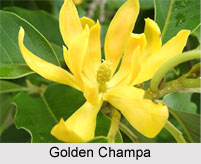 Golden Champa is an Indian Plant which has lots of medicinal uses. The Golden Champa tree contains highly scented yellow flowers that are very popular among the people of India. The flowers are especially popular amongst the Hindu women who love to adorn their hair with them. The flowers are also used for `Puja`. For this reason, this tree is commonly found around temples of India.
Golden Champa is an Indian Plant which has lots of medicinal uses. The Golden Champa tree contains highly scented yellow flowers that are very popular among the people of India. The flowers are especially popular amongst the Hindu women who love to adorn their hair with them. The flowers are also used for `Puja`. For this reason, this tree is commonly found around temples of India.
Naming of Golden Campa
The scientific name of Golden Champa is `Michelia Champaca` and its family is `Magnoliaceae`. The name `Michelia` was given in order to honour a Florentine botanist, P. A. Micheli. It is called as `Champa` and `Champaka` in both Bengali and Hindi languages. The name Champaka is derived from the Sanskrit name `Champaka`. It is `Chembuga` or `Chambugam` in Tamil and `Champaka` in Telugu.
Characteristics of Golden Campa
If provided with suitable conditions, the `Golden Champa` tree can rise up to 30m in height. It needs plain land or low hills and sufficient rainfall to appear in its fullest glory. The tree never gets leafless. The leaves of this tree are a little similar with that of Mango tree. They are long and curvy-edged and also have a silky-smooth bloom before they open out. The scent of the flowers fills up a huge area surrounding the tree twice in a year during the months of May and October.
 The sepals and petals of the flower are of the same golden-yellow colour. They appear like twelve to fifteen slender, pointed petals. They usually grow in the axils of the leaves with curved stems and when in bud, they are covered by a pinkish-yellow sheath. There are some varieties of the flowers. One kind of them is white and creamy-white and another one is golden-orange in colour. These golden-orange coloured flowers are undoubtedly the most favoured variety and highly scented.
The sepals and petals of the flower are of the same golden-yellow colour. They appear like twelve to fifteen slender, pointed petals. They usually grow in the axils of the leaves with curved stems and when in bud, they are covered by a pinkish-yellow sheath. There are some varieties of the flowers. One kind of them is white and creamy-white and another one is golden-orange in colour. These golden-orange coloured flowers are undoubtedly the most favoured variety and highly scented.
The common Champa are able to produce plenty of seeds. In fact, the golden champa tree becomes so much exhausted with the extravagance of its output that it takes another two to three years to gather enough strength to be able to flower again. The wise gardeners remove many of the fruit clusters of the `Golden Champa` tree before they develop to make sure that the tree flowers every year. The colour of the seeds is coral-red and peach green, dotted carpel contains two or more seeds.
Uses of Golden Champa
The yellow-brown timber of the tree has some great values and it can be used for making almost anything from cabinet to firewood. The tree has a large variety of uses in medicine as well. The concoctions obtained from the bark can make a good tonic and also can be utilized as a cure for coughs and rheumatism. The scented oil yielded from the flowers is considered to relieve eye troubles and gout.



















